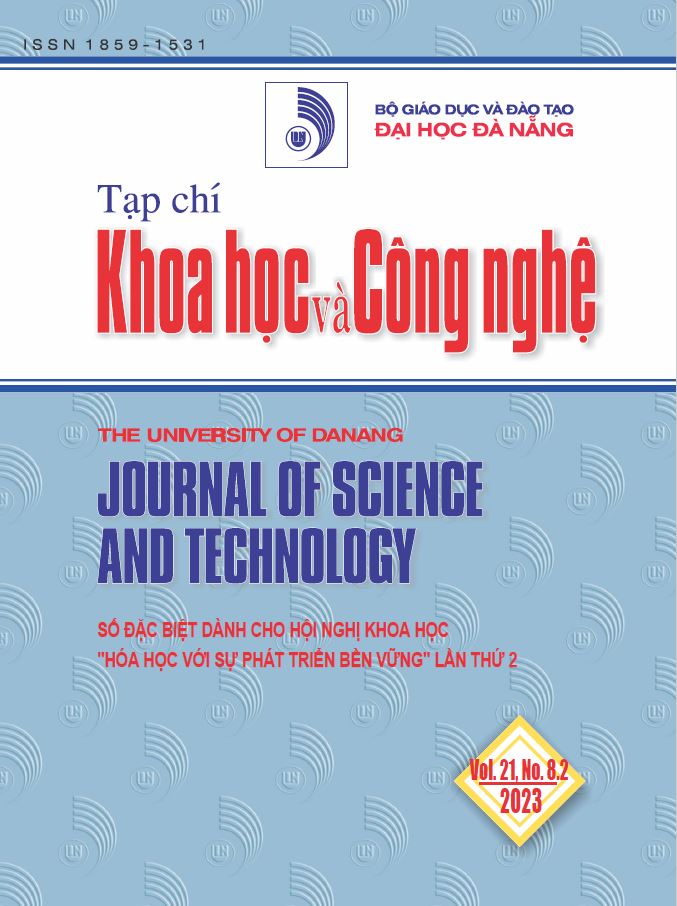Tổng hợp và nghiên cứu khả năng hấp phụ khí CO2 của vật liệu khung hữu cơ kim loại MIL-101
 Tóm tắt: 443
Tóm tắt: 443
 |
|  PDF: 641
PDF: 641 
##plugins.themes.academic_pro.article.main##
Author
-
Phạm Cẩm NamTrường Đại học Bách khoa - Đại học Đà Nẵng, Đà Nẵng, Việt NamNguyễn Thị Diệu HằngTrường Đại học Bách khoa - Đại học Đà Nẵng, Đà Nẵng, Việt NamPhan Thị Việt HàTrường Đại học Duy Tân, Đà Nẵng, Việt NamTrần Nguyên TiếnTrường Đại học Duy Tân, Đà Nẵng, Việt Nam
Từ khóa:
Tóm tắt
Trong nghiên cứu này, một loại vật liệu khung kim loại - hữu cơ có độ xốp cao với hệ thống lỗ xốp trật tự và đồng đều là MIL-101 (Cr), được tổng hợp từ phản ứng nhiệt dung môi của muối chromium và các phối tử carboxylate. Các tinh thể MIL-101 (Cr) với kích thước nano sau khi tổng hợp được khảo sát chi tiết bởi nhiều kỹ thuật khác nhau bao gồm phương pháp nhiễu xạ tia X (XRD), kính hiển vi điện tử quét (SEM), phân tích nhiệt trọng trường (TGA), phổ hồng ngoại biến đổi Fourier (FT-IR) và các phép đo hấp phụ N2. Các đường đẳng nhiệt hấp phụ CO2 của MIL-101 (Cr) được đo ở các nhiệt độ khác nhau, cụ thể là 293 K, 298 K, 303 K và 308 K. Kết quả thu được cho thấy, MIL-101 (Cr) là chất hấp phụ khí CO2 đầy tiềm năng với dung lượng hấp phụ cực đại là 2,08 mmol/g (tại T = 298 K) và độ bền hấp phụ tuyệt vời sau 5 vòng lặp hấp phụ.
Tài liệu tham khảo
-
[1] Specht, T. Redemann, and N. Lorenz. "Simplified mathematical model for calculating global warming through anthropogenic CO2”. International Journal of Thermal Sciences, vol. 102. pp. 1-8. 2016.
[2] Yang et al., "Progress in carbon dioxide separation and capture: A review”. Journal of environmental sciences, vol. 20, no. 1. pp. 14-27. 2008.
[3] Xiao, Q. Wei, and H. Wang. "Marginal abatement cost and carbon reduction potential outlook of key energy efficiency technologies in China׳ s building sector to 2030”. Energy Policy, vol. 69, no. C. pp. 92-105. 2014.
[4] M. Eisenberger et al., “Global warming and carbon-negative technology: Prospects for a lower-cost Route to a lower-risk atmosphere”. Energy Environ, vol. 20, no. 6, pp. 973–984, 2009.
[5] F. Deng et al., “Synthesis and CO2 capture properties of mesoporous carbon nitride materials”. Chem. Eng. J., vol. 203, pp. 63−70, 2012.
[6] H. Khoo, I. Halim, and A. D. Handoko. "LCA of electrochemical reduction of CO2 to ethylene”. Journal of CO2 Utilization, vol. 41. pp. 101229-101238. 2020.
[7] Kuramochi, A. Ramírez, W. Turkenburg, and A. Faaij, "Comparative assessment of CO2 capture technologies for carbon-intensive industrial processes”. Progress in energy and combustion science, vol. 38, no. 1. pp. 87-112. 2012.
[8] D. Eisaman et al., "CO2 separation using bipolar membrane electrodialysis”. Energy & Environmental Science, vol. 4, no. 4. 2011. pp. 1319-1328.
[9] Thi-Huong, L. Byeong-Kyu, and K. Jitae. "Novel improvement of CO2 adsorption capacity and selectivity by ethylenediamine-modified nano zeolite”. Journal of the Taiwan Institute of Chemical Engineers, vol. 66. pp. 239-248. 2016.
[10] Ghanbari, F. Abnisa, and W. M. A. W. Daud. "A review on production of metal organic frameworks. MOF) for CO2 adsorption”. Science of The Total Environment, vol. 707. p. 135090. 2020.
[11] Madejski, K. Chmiel, N. Subramanian, and T.Kuś, "Methods and techniques for CO2 capture: Review of potential solutions and applications in modern energy technologies”. Energies, vol. 15, no. 3. p. 887. 2022.
[12] S. Sifat and Y. Haseli. "A critical review of CO2 capture technologies and prospects for clean power generation”. Energies, vol. 12, no. 21. pp. 4143-4149. 2019.
[13] Song et al., "Molecular layer deposition-modified 5A zeolite for highly efficient CO2 capture”. ACS applied materials & interfaces, vol. 10, no. 1. pp. 769-775. 2018.
[14] Zou, M. Dong, and T. Zhao. "Advances in Metal-Organic Frameworks MIL-101. Cr)”. International Journal of Molecular Sciences, vol. 23, no. 16. pp. 9380--9396. 2022.
[15] Furukawa, K. E Cordova, M. O'Keeffe, and O. M Yaghi, "The chemistry and applications of metal-organic frameworks”. Science, vol. 341, no. 6149. p. 1230444. 2013.
[16] U. Czaja, N. Trukhan, and U. Müller. "Industrial applications of metal–organic frameworks”. Chemical Society Reviews, vol. 38, no. 5. pp. 1284-1293. 2009.
[17] D. Sosa et al., "Metal–organic framework hybrid materials and their applications”. Crystals, vol. 8, no. 8. p. 325. 2018.
[18] Y. Zorainy, M. G. Alalm, S. Kaliaguine, and D. C. Boffito, "Revisiting the MIL-101 metal–organic framework: design, synthesis, modifications, advances, and recent applications”. Journal of Materials Chemistry A, vol. 9, no. 39. pp. 22159-22217. 2021.
[19] Férey et al., "A chromium terephthalate-based solid with unusually large pore volumes and surface area”. Science, vol. 309, no. 5743. pp. 2040-2042. 2005.
[20] P. Jeppu and T. P. Clement. "A modified Langmuir-Freundlich isotherm model for simulating pH-dependent adsorption effects”. Journal of contaminant hydrology, vol. 129-130. pp. 46-53. 2012.
[21] Thakkar, Ahlam Issa, A. A. Rownaghi, F. Rezaei, "CO2 Capture from Air Using Amine‐Functionalized Kaolin‐Based Zeolites”. Chemical Engineering & Technology, vol. 40, no. 11. pp. 1999-2007. 2017.
[22] -Y. Kim, J. Kim, S.-T. Yang, W. Ahn, "Mesoporous SAPO-34 with amine-grafting for CO2 capture”. Fuel, vol. 108. pp. 515-520. 2013.
[23] Yang, L. Ge, V. Rudolpha, and Z. Zhu, "In situ synthesis of zeolitic imidazolate frameworks/carbon nanotube composites with enhanced CO2 adsorption”. Dalton transactions, vol. 43, no. 19. pp. 7028-7036. 2014.
[24] B. Wang, A. P Côté, H. Furukawa, M. O'Keeffe, and O. M Yaghi. "Colossal cages in zeolitic imidazolate frameworks as selective carbon dioxide reservoirs”. Nature, vol. 453, no. 7192. pp. 207-211. 2008.



